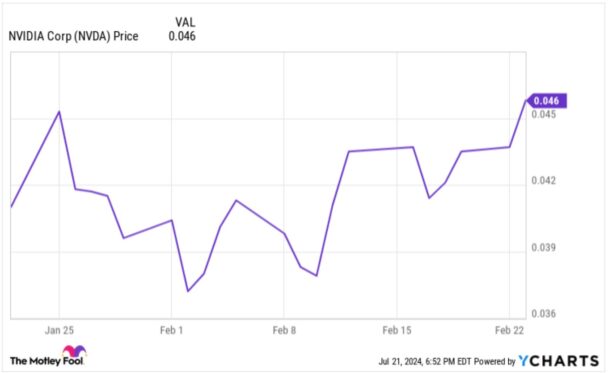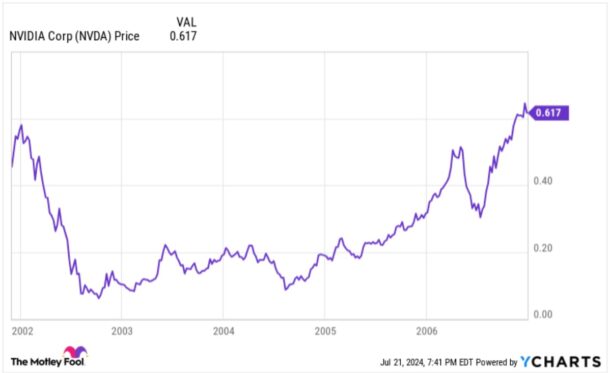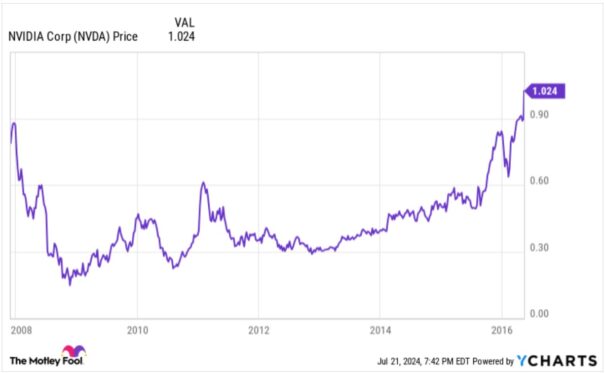This article was originally published on Fool.com. All figures quoted in US dollars unless otherwise stated.
Anyone who thought Nvidia Corp (NASDAQ: NVDA)'s sizzling momentum would go on forever without a hitch should now know better. A hitch has unquestionably arrived.
Sure, the high-flying artificial intelligence (AI) stock is still up close to 140% year to date. However, Nvidia stock has pulled back over 10%. Here's what history says could happen next.
A track record of pullbacks and rebounds
Nvidia has fallen by double-digit percentages from its high plenty of times since its stock began trading publicly in 1999. The first one came only days after its initial public offering. However, within a few weeks, Nvidia shrugged off the temporary setback and marched to a new high.

Several other pullbacks of 10% or more occurred during Nvidia's first year on the market. In each case, the stock bounced back. However, Nvidia's sell-offs weren't always short-lived. Between late 2001 and October 2002, shares of the graphics processing unit (GPU) maker plunged nearly 90%. Nvidia didn't climb back to its previous high until December 2006.

And that wasn't Nvidia's longest trough. The stock market sell-off that began in late 2007 sparked another huge sell-off of Nvidia. Although the worst was over by the latter part of 2008, it took the stock over eight years — until May 2016 — to recover.

However, Nvidia always eventually bounced back after a major decline. Given enough time, the stock has a 100% rebound rate historically.
Is this time different for Nvidia?
Investors shouldn't automatically conclude that history will repeat itself. Just because Nvidia has come back from big pullbacks in the past doesn't mean that it will necessarily do so again. Could this time be different for Nvidia?
Nvidia has never had a market cap of over $3 trillion before a double-digit percentage sell-off until now. The company is clearly at a different stage than it's ever been. Some could argue that Nvidia's valuation makes things different now than in the past.
I question that premise, though. Based on several valuation metrics (including price-to-earnings ratio and price-to-free-cash-flow), Nvidia isn't as expensive as it's been at other times in its history.
The factors that contributed to Nvidia's lengthy downturns in the past aren't problems today, either. While many tech stocks trade at a premium, valuations aren't at the excessive levels seen in the dot-com boom. There is no financial crisis like we saw in 2007 through 2009. Overall, the macroeconomic conditions are pretty good for Nvidia right now.
Nvidia's current double-digit decline is mainly due to concerns about China. Bloomberg reported last week that the Biden administration could further restrict exports of chipmaking equipment to China. Soon afterward, GOP presidential nominee Donald Trump suggested that Taiwan should pay the United States for defending it against attack. Although these developments are concerning for Nvidia, they don't rise to the level of the issues that have caused extended declines for the stock in the past.
Look to Nvidia's future instead of its past
I think that history is on the side of a relatively quick rebound for Nvidia. But I'd also argue that investors should look to the company's future instead of its past. Nvidia's share price won't bounce back because it's always done so. It will bounce back if investors are convinced that growth prospects present a compelling case for buying the stock.
On that front, there's reason to be optimistic. Nvidia will soon launch new chips based on its Blackwell architecture. CEO Jensen Huang believes Blackwell will be the company's "most successful product" in its history. If he's right, the current pullback presents a great buying opportunity.
This article was originally published on Fool.com. All figures quoted in US dollars unless otherwise stated.









